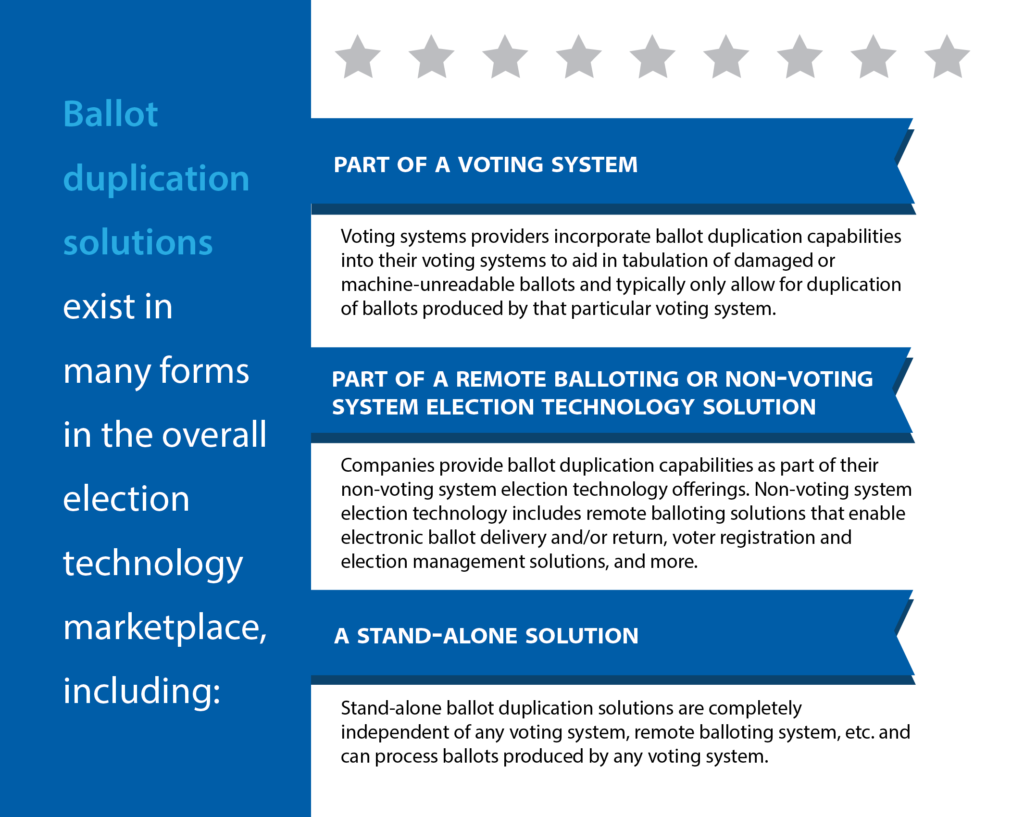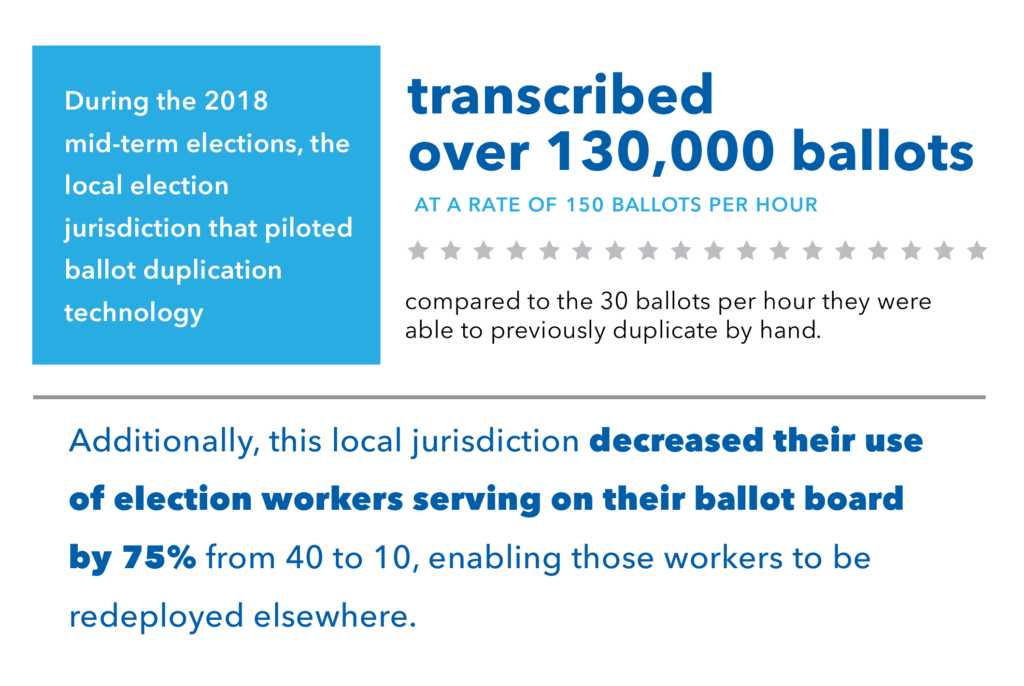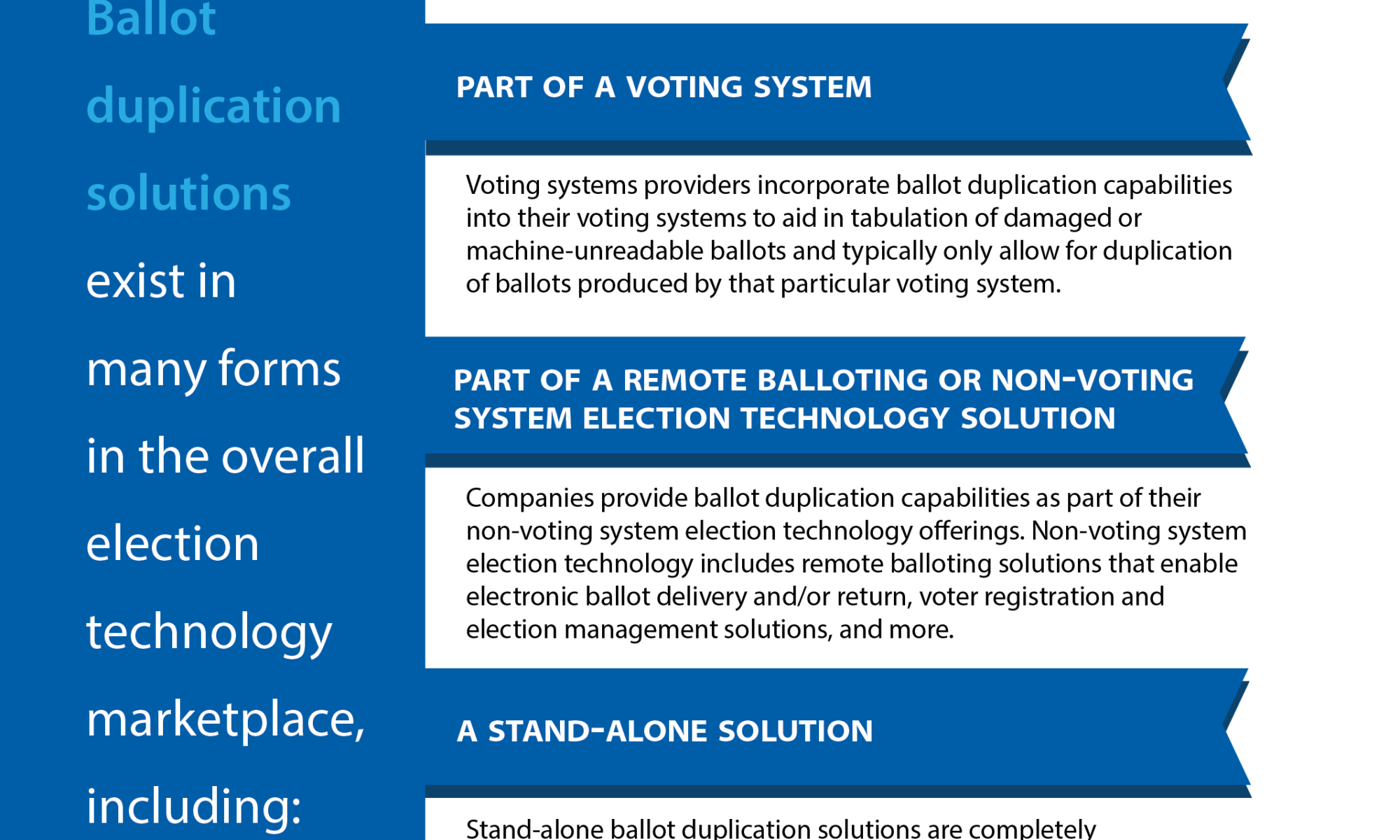In this post, we’ll provide a general overview of the ballot duplication technology landscape and its innovation since OVI began to research this topic in 2016. We’ll then briefly highlight a local jurisdiction’s first use of ballot duplication technology in 2018 and how this advancement has proven helpful in processing their damaged or otherwise machine-unreadable ballots prior to counting.
What does the ballot duplication technology marketplace look like?
Ballot duplication technology is a relatively new and evolving area of election technology with solutions that have been introduced to the marketplace gradually over the past five years. Election technology offerings continually evolve to address the changing and expanding needs of election jurisdictions across the country.
Ballot duplication solutions are generally comprised of software and hardware used to automate the transcription of damaged or otherwise machine-unreadable ballots. The technology designed to transcribe the ballots efficiently and accurately within a transparent and verifiable environment. Ballot duplication hardware components are usually commercially available scanners, printers and computer workstations.

Ballot duplication solutions exist in many forms in the overall election technology marketplace, including as:
-
- Part of a Voting System — Voting systems providers such as Clear Ballot, Dominion Voting and Election Systems & Software incorporate ballot duplication capabilities into their voting systems to aid in tabulation of damaged or machine-unreadable ballots and typically only allow for duplication of ballots produced by that particular voting system.
- Part of a Remote Balloting or Non-Voting System Election Technology Solution — Companies like Democracy Live provide ballot duplication capabilities as part of their non-voting system election technology offering. Non-voting system election technology includes remote balloting solutions that enable electronic ballot delivery and/or return, voter registration and election management solutions and more. In the case of Democracy Live, its ballot duplication capabilities are housed within its remote balloting solution offerings.
- A Stand-Alone Solution — Stand-alone ballot duplication solutions are completely independent of any voting system, remote balloting system, etc., and can process ballots produced by any voting system. Runbeck Election Services is an example of provider of stand-alone ballot duplication solutions.
How has ballot duplication technology evolved since 2016?

Since 2016, ballot duplication technology solutions have advanced in areas that include increased processing speed and efficiency, greater flexibility and scalability and expanded functionality.
Ballot duplication technology solutions have also become increasingly flexible and scalable for use in any election jurisdiction regardless of size, allowing resources to be redirected to other areas of election administration as needed. Some solutions can even be used simultaneously by multiple duplication teams. Therefore, as the number of ballots requiring duplication increases, duplication teams can easily be added, with some solutions accommodating up to 20 processing teams. Conversely, this technology can scale down to handle small elections in large jurisdictions while also meeting the needs of smaller jurisdictions.
The ballot duplication technology marketplace in 2020 offers expanded functionality that includes enhanced auditing and reporting options. For ease of use, the ability for the duplication software to work in a touchscreen environment and the capability to communicate directly with printers, scanners and other election technology solutions have been extremely important.
Individual ballot duplication technology solutions offer different features with associated benefits to meet the needs, requirements and preferences of election jurisdictions of all sizes. While we’ve referenced a few companies, who offer ballot duplication technology solutions, this is not an exhaustive list or an endorsement of any particular provider or solution. OVI encourages election officials to contact election technology providers if and when interested in exploring ballot duplication technology options.
How does ballot duplication technology perform in the field?
As explained in previous posts, higher levels of by-mail and remote ballot return can result in an increase in damaged ballots. An increase in the number of damaged ballots means an increase in the use by election officials of both manual and technology-assisted solutions to transcribe these ballots prior to tabulation. Thus, we expect a significant opportunity to learn more about how specific ballot duplication technology solutions assist election officials during the Nov. 3, 2020 election.
The technology has shown significant promise during recent pilots in 2018 and early 2020. We are going to reference these pilots in general terms now. We will explore how it fared in 2020 as well as a deeper dive on the technology during some blog entries during the first quarter of 2021.
One large local jurisdiction that initially piloted ballot duplication technology in 2018 reported a Permanent Early Voting List with over 1.6 million of its registered voters automatically receiving a ballot by mail. This jurisdiction still has significant Early Voting in-person and Election Day voting in polling places. This jurisdiction managed significant manual ballot duplication throughout the years. It was interested in seeing how technology could potentially improve this tedious, labor-intensive, yet integral election process.
Previous to this pilot, this local jurisdiction held all their pre-printed ballot styles for their manual duplication process in distinct piles in an enormous room full of metal shelving. The jurisdiction would print a significant quantity of ballots for each style and store them in piles these on the shelves. A “runner” would then “pick and pull” an individual ballot and deliver it to their ballot board team as needed to be manually duplicated.
The jurisdiction turned to its long-time election technology provider, Runbeck Election Services, for help in improving the efficiency and speed of processing their damaged and machine-unreadable ballots. Phoenix-based Runbeck primarily supplies mail and remote ballot processing solutions and ballot-on-demand technology offerings, in addition to ballot duplication technology solutions.

During the 2018 mid-term elections, the local election jurisdiction piloted Runbeck’s ballot duplication technology, Novus, transcribed over 130,000 ballots at a rate of 150 ballots per hour compared to the 30 ballots per hour they were able to previously duplicate by hand. Additionally, this local jurisdiction decreased their use of election workers serving on their ballot board dedicated to ballot duplication by 75% from 40 to 10, enabling those workers to be redeployed elsewhere.
During two smaller elections in 2020 — including a primary election — this same local jurisdiction duplicated over 2,300 ballots in the first election and over 4,500 ballots in the second election, keeping to their same 2018 numbers with regard to increased speed of processing these ballots. We’re interested in seeing how their use of ballot duplication technology — and that of other jurisdictions — fares on Nov. 3. Stay tuned during the first quarter of 2021.
Until then, we’ll be sharing frequently asked questions (with answers!) to help election officials everywhere discuss ballot duplication with external stakeholders, and then we’ll wrap up our 2020 ballot duplication series by highlighting remote observation of post-election processes — including ballot duplication — that some election jurisdictions are implementing for November 3rd due to the pandemic.
In the most recent post from the CSG Overseas Voting Initiative (OVI) ballot duplication blog series, we shared how ballot duplication technology works from a general perspective, not specific to any one solution or provider.
Read the other articles in our Ballot Duplication series:
Ballot Duplication: What it is, what it is not and why we are talking about it in 2020
Ballot Duplication: New Recommendations for Contingency Planning in the time of COVID-19 and Beyond
Ballot Duplication Technology: What Is It and How Does It Work?
Contingency Planning During COVID-19: Ballot Duplication in the States
Frequently Asked Questions (and Answers) About Ballot Duplication


